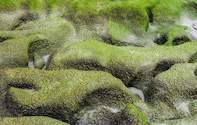
The death toll caused by blooms of blue-green algae, Microcystis, in some of Kruger's waterpoints has increased. Subsequent to the die-offs reported at Shilolweni dam in the Tshokwane section earlier this year, an additional impala (positively identified as dying of algal poisoning) and other carcasses, including a giraffe, have been found in the section.
More recently a fresh carcass of a white rhino bull was found and linked to an algal bloom in Sunset Dam near in the Lower Sabie section. Sunset Dam has had an algal bloom for the last three years, and this is the first fatality recorded at the dam. One reason for the almost complete lack of fatalities is that the Sabie River runs about 50 metres from the dam on its way to Mozambique. The animals probably prefer the cleaner Sabie water to the water in Sunset Dam.
Blue-green algae, or cyanobacteria, is one of the oldest known organisms on earth and is found in most water bodies in low numbers. However, under the right conditions they multiply to produce algal blooms, great masses of algae that discolour the water. The algae produce strong poisons, which can damage the nervous system and the liver of animals. In the case of an algal bloom, these toxins concentrate in the water at much higher levels than normally occur. Animals can be poisoned if they drink water containing enough Microcystis.
Previously the Park has breached the damwall of the Nhlanganzwane Dam near Crocodile Bridge rest camp after over 50 animal carcasses were recorded in 2005, plus more fatalities in 2007. This year Kruger rangers and technical services staff drained the Shilolweni dam to combat the algal bloom that caused a number of fatalities earlier this year. According to Freek Venter, head of conservation services in Kruger, the nutrient rich silt in the Shiloweni dam will be removed.
The 100 strong hippo population has moved to a stream east of the dam and to the nearby Orpen Dam. The park has decided on a different intervention to combat the algae bloom at Sunset Dam. Freek believes that draining the water will be less effective than as at Shilolweni Dam as the Sabie River is too close to Sunset and a preferred alternative for the 100 or so hippo in the area. The dam also attracts a huge tourist contingent. It was thus decided to pump water into Sunset Dam with the intention of diluting the bloom.
"If this does not work, we will probably have to consider draining the dam, as well," says Freek. He is reluctant to use a chemical option as "this will be a very temporary" solution. Several Kruger dams are due for destruction in terms of the park's rehabilitation and wilderness policies, as well as a transfrontier conservation area agreement that stipulates there will be no man made water structures in a 10 kilometre zone on either sides of the national borders.
By Lynette Strauss

 In the Kruger National Park there are five major rivers that historically flowed all year round – the Crocodile, the Sabie, the Olifants R...
In the Kruger National Park there are five major rivers that historically flowed all year round – the Crocodile, the Sabie, the Olifants R...